Related Research Articles

A cocktail is a mixed drink, usually alcoholic. Most commonly, a cocktail is a combination of one or more spirits mixed with other ingredients, such as juices, flavored syrups, tonic water, shrubs, and bitters. Cocktails vary widely across regions of the world, and many websites publish both original recipes and their own interpretations of older and more famous cocktails.

A Manhattan is a cocktail made with whiskey, sweet vermouth, and bitters. While rye is the traditional whiskey of choice, other commonly used whiskies include Canadian whisky, bourbon, blended whiskey, and Tennessee whiskey. The cocktail is usually stirred with ice then strained into a chilled cocktail glass and garnished traditionally with a maraschino cherry. A Manhattan may also be served on the rocks in a lowball glass.
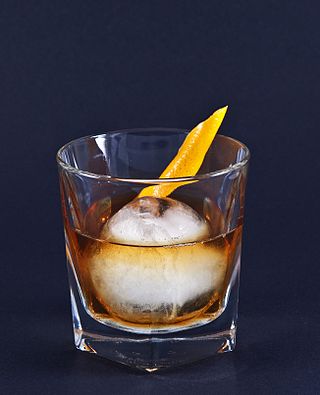
The old fashioned is a cocktail made by muddling sugar with bitters and water, adding whiskey or sometimes brandy, and garnishing with an orange slice or zest and a cocktail cherry. It is traditionally served with ice in an old fashioned glass.

A margarita is a cocktail consisting of tequila, triple sec, and lime juice. Some margarita recipes include simple syrup as well and are often served with salt on the rim of the glass. Margaritas can be served either shaken with ice, without ice, or blended with ice. Most bars serve margaritas in a stepped-diameter variant of a cocktail glass or champagne coupe called a margarita glass. The margarita is one of the world's most popular cocktails and the most popular tequila-based cocktail.

The Zombie is a Tiki cocktail made of fruit juices, liqueurs, and various rums. It first appeared in late 1934, invented by Donn Beach at his Hollywood Don the Beachcomber restaurant. It was popularized on the East coast soon afterwards at the 1939 New York World's Fair.

The sidecar is a cocktail traditionally made with brandy, orange liqueur, and lemon juice. It became popular in Paris and London in the early 1920s. Common modifications of the original recipe are a sugar rim, added sugar syrup, and an orange twist or lemon twist.
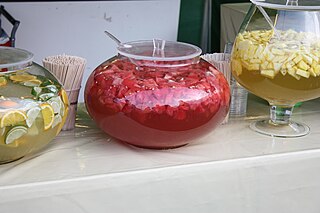
The term punch refers to a wide assortment of drinks, both non-alcoholic and alcoholic, generally containing fruits or fruit juice. The drink was introduced from the Indian subcontinent to England by employees of the East India Company in the late 17th century. Punch is usually served at parties in large, wide bowls, known as punch bowls.
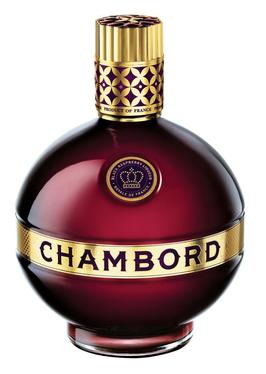
Chambord is a 16.5% abv raspberry liqueur modelled after a liqueur produced in the Loire Valley of France during the late 17th century. The Chambord product brand has been owned and produced by the Brown-Forman Corporation since 2006.
A Scorpion Bowl is a communally shared alcoholic tiki drink served in a large ceramic bowl traditionally decorated with wahine or hula-girl island scenes and meant to be drunk through long straws. Bowl shapes and decorations can vary considerably. Starting off as a single-serve drink known as the Scorpion cocktail, its immense popularity as a bowl drink in tiki culture is attributed to Trader Vic.

The Fine Art of Mixing Drinks is a book about cocktails by David A. Embury, first published in 1948. The book is noteworthy for its witty, highly opinionated and conversational tone, as well as its categorization of cocktails into two main types: aromatic and sour; its categorization of ingredients into three categories: the base, modifying agents, and special flavorings and coloring agents; and its 1:2:8 ratio for sour type cocktails.
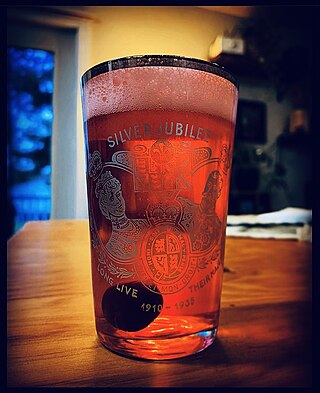
A beer cocktail is a cocktail that is made by mixing beer with other ingredients or another style of beer. In this type of cocktail, the primary ingredient is usually beer.
Aurum is a sweet orange-flavored Italian liqueur produced in Pescara since 1925. It is 40% alcohol by volume and it is made from aged brandy and a citrus fruit infusion consisting of orange rind, orange juice and saffron. The saffron serves to imbue it with a deep yellow coloration. Aurum has been described as a digestif. It goes well with sweets, especially with parrozzo, another specialty of Pescara. Other than as a drink, it is often used as a cake ingredient or as an addition to ice-cream.

In terms of mixed drinks, shrub is the name of two different, but related, acidulated beverages. One type of shrub is a fruit liqueur that was popular in 17th and 18th century England, typically made with rum or brandy and mixed with sugar and the juice or rinds of citrus fruit.
Sweet Revenge is a 77-proof liqueur with natural flavorings that include wild strawberry and citrus, according to the manufacturer's website, literature and public trademark documents. It is essentially a blended sour mash whiskey flavored with fruit syrup(s). The liqueur has a vivid semi-translucent pink color and a sweet, assertive strawberry-dominant flavor. Sweet Revenge is marketed in a 750 mL size bottle with a silhouette similar to that of vintage American whiskey brands. It is promoted as a shot beverage with relatively high alcohol content – the liqueur is typically served undiluted in a shot glass or on the rocks.
Charles Jacquin et Cie, Inc. (Jacquin's) is a producer, distiller, rectifier, manufacturer, and importer of alcoholic beverages and food products. It is a wholly owned subsidiary of Chatam International Incorporated, and is based in Philadelphia, Pennsylvania. The company was founded in 1884 by Charles Jacquin, a Frenchman who emigrated to Philadelphia. It claims to be the oldest producer of cordials in the United States and the only cordial producer in Pennsylvania.

Italicus Rosolio di Bergamotto is a bergamot rosolio manufactured in Italy. The liqueur uses bergamot from Calabria and citrons from Sicily, along with Italian flower varieties. Italicus was created by an Italian bartender, Giuseppe Gallo, using a family recipe. He launched the spirit commercially in September 2016.
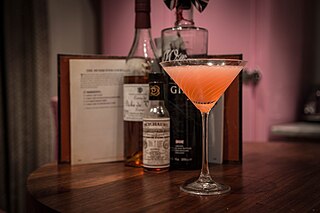
The Pendennis Club cocktail is a cocktail created at the private club of the same name, the Pendennis Club of Louisville, Kentucky, in or shortly before 1911. It experienced a minor revival in the 2010s, but as of 2024 it remains uncommon.
References
- 1 2 "Forbidden Fruit | Lee Spirits Co" . Retrieved 2020-01-25.
- ↑ "World Wide Words: Grapefruit". World Wide Words. Retrieved 2020-01-25.
- ↑ "The Bustanoby Family History Project - Huntington, Long Island, Pau, France". 2016-02-04. Archived from the original on 2016-02-04. Retrieved 2020-01-25.
- 1 2 Historians, The. "LOST INGREDIENTS: Forbidden Fruit". DrinkWire. Retrieved 2020-01-25.
- ↑ "CocktailDB: The Internet Cocktail Database | Forbidden Fruit". 2015-09-05. Archived from the original on 2015-09-05. Retrieved 2020-01-25.
- ↑ . 2016-06-09 https://web.archive.org/web/20160609192754/http://bustanobys.com/patent.pdf. Archived from the original (PDF) on 2016-06-09. Retrieved 2020-01-25.
{{cite web}}: Missing or empty|title=(help) - ↑ Embury, David A. (1948). The Fine Art of Mixing Drinks. Doubleday. p. 184. ISBN 9780571054121.
- ↑ "Forbidden Fruit Liqueur". Three Points Kitchen. 2015-04-15. Retrieved 2020-01-25.